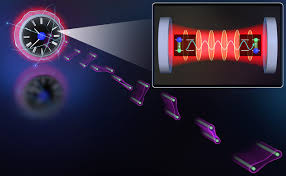GS3 – Science & Technology

Context:
Scientists propose using entangled atomic clocks to experimentally investigate interactions between quantum mechanics and general relativity in curved spacetime.
Experimental Probe of Quantum-Gravity Interface:
- Quantum Mechanics: Describes atomic behavior through superposition, entanglement, and probabilistic principles.
- General Relativity: Explains gravity as curvature of spacetime affecting planetary and cosmic motion.
- Conflict Zone: Both frameworks function well independently but diverge under overlapping extreme conditions.
Proposed Experiment:
- Concept: Quantum-entangle three atomic clocks placed at kilometre-scale height differences.
- Prediction: Spacetime curvature leads to nonlinear variations in time flow.
- Verification: Entangled clocks directly measure relativistic time differences.
- Objective: Test quantum behavior under curved spacetime by observing measurable frequency shifts.
Significance:
- Quantum Validation: Provides the first laboratory evidence of quantum mechanics in curved spacetime.
- Applications: Potential for satellite technology, dark matter research, and gravitational wave detection.
Challenges:
- State Fragility: Entangled states are susceptible to decoherence, limiting stability.
- Measurement Precision: Detecting frequency shifts requires unprecedented accuracy.
Major Terms Explained:
- Atomic Clocks: Devices measuring time via atomic energy oscillations.
- Quantum Entanglement: Instantaneous influence between linked particles across distances.
- Spacetime: Four-dimensional construct of three spatial dimensions plus time.
- Spacetime Curvature: Massive objects bend spacetime, causing gravity and trajectory changes.
- Decoherence: Loss of quantum superposition due to environmental interactions.
- Frequency Shifts: Changes in atomic clock oscillation rates due to gravity or motion.




